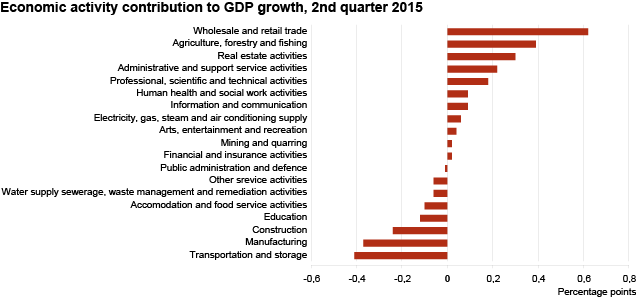Economy grew in the 2nd quarter
In the 2nd quarter, the seasonally and working-day adjusted GDP increased by 0.7% compared to the 1st quarter of 2015 and 1.9% compared to the 2nd quarter of 2014.
In the 2nd quarter, the GDP at current prices was 5.2 billion euros.
In the 2nd quarter of 2015, the GDP growth was influenced the most by a rise in the value added of trade, real estate activities and agriculture, forestry and fishing. The Estonian economy was also positively influenced by increased receipts of value added tax. At the same time, payments of subsidies decreased.
According to the second estimates, the GDP growth was inhibited the most by a decrease in value added in transport, also by the decrease in manufacture and construction. In the 2nd quarter, the decline in manufacture was broad-based, the value added decreased in more than half of manufacturing activities. The main contributors to the growth of manufacturing were electrical equipment, mineral products and machinery. However, the manufacture of food and beverages substantially decreased the contribution of the largest economic activity to the GDP in Estonia. The value added in construction decreased mainly due to a decrease in construction volumes.
The export of goods and services decreased at real prices by 1.1%. Although the export of electronic products, wood and products thereof increased, the significant decrease in the export of machinery and equipment n.e.c., and food and beverages led to a decrease in the export of goods and services. Total import decreased at real prices by 3.3% compared to the 2nd quarter of the previous year mainly due to the decrease in the import of machinery and equipment n.e.c., electronic products, and beverages.
In the 2nd quarter of 2015, the share of net export has increased, amounting 5.7% of the GDP.
Real GDP grew slower than the number of persons employed (2.1%), but faster than hours worked (1.2%). Unit labour costs increased 4.6% compared to the same quarter of the previous year. This means that compensation per employee has grown faster than productivity (-0.1%).
Domestic demand decreased at real prices due to the changes in inventories and the gross fixed capital formation. The last time domestic demand decreased at real prices was in the 2nd quarter of 2013.
In the 2nd quarter of 2015, the changes in inventories (in all subcategories) were negative. The largest decrease was in the inventories of finished goods. The last time the changes of inventories were negative was in the 4th quarter of 2013. The decrease of gross fixed capital formation decelerated to 8% in the 2nd quarter of 2015 mainly due to the decrease in the investments in transport equipment and buildings, and structures by non-financial corporations.
The final consumption expenditures increased 4.3%. Thereby the household final consumption expenditure increased by 5.4%. The expenditures on food, recreation and household equipment increased the most.
In the 2nd quarter, domestic demand continued to be smaller than the GDP, accounting for 92.4% of the GDP.Statistics Estonia revised the GDP time series data for 1995-1999 onwards. The data have been recalculated on the basis of the European Parliament and the Council Regulation (EU) No 549/2013 on the European system of national and regional accounts in the European Union (ESA 2010). To keep coherency of time series, calculations for 2000-2010 were updated. According to the regular revision, Statistics Estonia revised the national accounts data for 2011–2014 based on the supply and use tables and annual reports of enterprises.
Since the implementation of the ESA 2010 methodology in September 2014, Statistics Estonia and Eesti Pank harmonised their revision policy of national accounts and balance of payments estimates. In conjunction with the publication of the estimates for the 2nd quarter of 2015, the estimates for the 1st quarter of 2015 were also revised.
Additional information about the revisions in 2015 is available here.
